Taking a step away from the workplace for this blog post!
To celebrate our HSE National Breastfeeding Week (1st – 7th October) I am highlighting the risks associated with breastfeeding that can cause musculoskeletal discomfort and what you can do to stay comfortable when feeding your baby.
As a mother of 2 children, both of whom breastfed for just over 2 years, I am all too aware of the aches and pains associated with breastfeeding. From static postures, to awkward postures and repetitive rocking movements, I have been there.
One of the main issues is that new mothers are usually so focused on the baby and making sure they have a good latch and are getting enough milk, especially in the early days, that they forget about themselves, and can contort themselves into the oddest postures for as long as baby stays latched. We ignore the aches and pains, putting them down to the demands of motherhood. These niggles, if left unaddressed, can worsen to become a source of chronic pain.
The posture of the mother when breastfeeding is important. The different postures and holds have benefits for the different stages of breastfeeding.
There are four common breastfeeding positions for newborn and young babies.
The under arm / football hold is good when feeding premature and newborn babies or following a Caesarean delivery as it allows the mother to see the babies face, improve head control and reduce pressure on the Caesarean wound.
The cross-cradle & cradle holds are good for when feeding premature babies, newborn babies, if the baby has a poor latch or low level of head control.
The laying down method is good for nighttime feeding, post Caesarean delivery or if you have a forceful letdown.
The supine or laid back position is great for encouraging newborn feeding instincts, post Caesarean delivery and encouraging newborn latch.
The upright or koala hold is great for feeding older babies once they are able to sit upright.
The dangle nursing position can be useful for clearing blocked ducts.
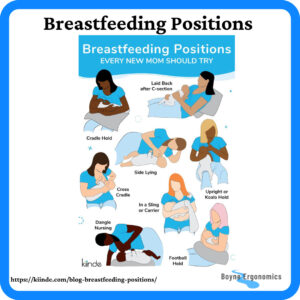
Breastfeeding positioning and musculoskeletal comfort have been identified as two of the factors that contribute to continued breastfeeding past the newborn stage. Learning to breastfeed in a comfortable, supported posture can help reduce the risk of musculoskeletal discomfort.
What Are The Musculoskeletal Risks Associated With Breastfeeding?
The common areas of reported musculoskeletal discomfort among breastfeeding mothers are the neck, upper back, shoulders, lower back, elbows and wrist / hand. But what are the causes of these musculoskeletal issues?
Prolonged Static Postures
Breastfeeding mothers can, especially in the early days, be exposed to prolonged periods in the seated, lying or reclined position.
When we are static, the muscles are contracting but there is minimal movement. The muscles are using energy and making lactic acid as a by-product.
Too long in the one position decreases the rate of circulation around the body, reducing the removal of waste products from the muscles, reducing the provision of oxygen and nutrients to the muscles, increasing the risk of inflammation and strain on the muscles and tendons, causing discomfort.
Adverse Postures
Breastfeeding mothers can often adopt adverse postures to encourage the baby to latch and feed. This can be adverse upper back, neck and shoulder postures when bringing the breast to the baby, adverse wrist and hand positioning when supporting the baby whole feeding and adverse postures of the lower back due to poor seating and side leaning when feeding.
Adverse postures can also impact milk flow and latch quality, contributing to breast and nipple discomfort.
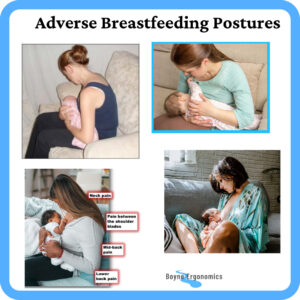
Inadequate Back Support
Breastfeeding mothers can sometimes find that they support the weight of the baby when feeding.
They can also experience inadequate lower back support when feeding in the seated and reclined position.
Psychological Risk Factors
The newborn stage can be physically and emotionally demanding. Fatigue, pain, anxiety over establishing breastfeeding patterns, anxiety over typical newborn development patterns, overwhelm, post-natal depression and the change in the dynamics of relationships can cause an increase in psychological stress and anxiety.
This increase in stress and anxiety can cause increased tension in the muscles, contributing to the risk of developing musculoskeletal discomfort.
How Can You Reduce The Musculoskeletal Risks Associated With Breastfeeding?
Get Comfortable
The first thing I learned when I started my breastfeeding journey was the importance of getting comfortable when feeding. For me, that meant finding clothing I could easily adjust to feed in (breastfeeding tops or even vest tops under tshirts are great!) and finding a spot in the house where I could set up what I called the feeding station. It was on the right side of the sofa, with a side table next to me where I had all I needed for feeding time, including a drink for myself and the tv remote control! My first was a clingy baby and a marathon feeder, with feeding sessions exceeding an hour each, every 2-3 hours. It was intense!
I quickly learned what cushions and pillows I needed to feel supported.
Feeding chairs are a great option if you have the space to accommodate one.
Try different feeding positions to find what works for you and baby.
Avoid Prolonged Static Postures
Aim to avoid being in the one position for longer than 45 minutes. When baby takes a break from feeding, for example for winding, use that as an opportunity to move around for a minute or two to increase circulation, remove waste products and provide nutrients and oxygen to the muscles and reduce strain and tension in the muscles.
Carrying the baby around while winding, even for a minute will help reduce discomfort caused by prolonged sitting.
As hard as it can be, take breaks from gazing down at baby when feeding to reduce neck strain.
One thing I learned to do, mostly out of necessity because my first was so clingy and would only nap on me, was to use a sling, also known as a baby carrier. First, I got comfortable with the different types of slings so I could secure baby to me safely and was confident with the different types and ties. Once I was comfortable with using them, I was able to learn how to feed her while she was in it, allowing me to feed on the move. I was no longer tied to the sofa for feeding times.
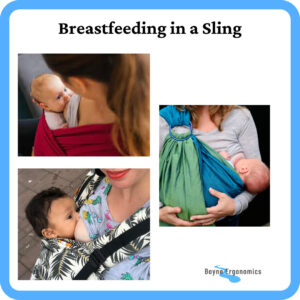
Reduce Adverse Postures
One of the ways to reduce adverse postures when breastfeeding, especially during the early days, is to ensure that you bring baby to the breast, instead of bringing the breast to the baby.
Ensure that you are using the feeding positions that you are comfortable with and that suit the environment that you are feeding in.
If you are seated, make sure your feet are planted, on the floor or on a footstool.
If the edge of the chair is pressing against the back of your legs, use a pillow to support your back and shorten the depth of the seat.
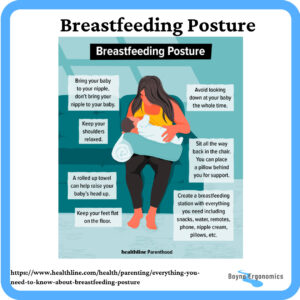
Ensure You & Baby Are Supported When Feeding
Whether feeding in the seated, reclined or lying position make sure that your lower back is supported with pillows or cushions.
To reduce strain associated with holding baby to the breast, use pillows and cushions to bring the baby into position without strain on the shoulders and arms.
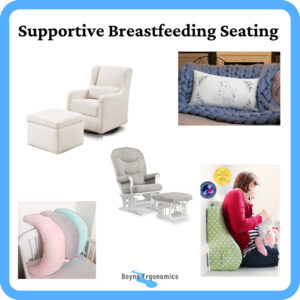
Reduce Psychological Risk Factors
Firstly, it is important to know that breastfeeding, although natural, does not always come easy and there can be issues and challenges associated with it. Reach out for support from your local public health nurse, lactation consultant or breastfeeding support group if you have any concerns or questions. Personally, I found the breastfeeding support groups to be great for tips and tricks to get through the first few weeks and even just for reassurance.
Reach out for support from family and friends and accept help that is offered!
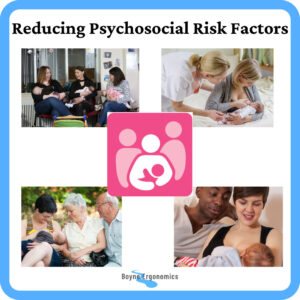
Remember, the ergonomics will change as baby grows, gets heavier and discovers new motor skills. Feeding patterns will change too. By ensuring you are supported when feeding, move as frequently as you can and stay hydrated, you will reduce the risk of developing musculoskeletal discomfort during this wonderfully demanding time.


